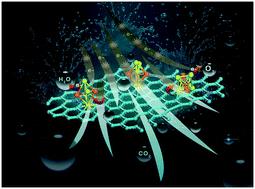当前位置:
X-MOL 学术
›
Environ. Sci.: Nano
›
论文详情
Our official English website, www.x-mol.net, welcomes your
feedback! (Note: you will need to create a separate account there.)
Vanadium tetrasulfide cross-linking graphene-like carbon driving a sustainable electron supply chain from pollutants through the activation of dissolved oxygen and hydrogen peroxide
Environmental Science: Nano ( IF 5.8 ) Pub Date : 2020-12-17 , DOI: 10.1039/d0en00982b Kanglan Deng 1, 2, 3, 4, 5 , Tingting Gao 1, 2, 3, 4, 5 , Qian Fang 4, 6, 7, 8 , Feiyun Wu 4, 6, 7, 8 , Chao Lu 1, 2, 3, 4, 5 , Fan Zhang 1, 2, 3, 4, 5 , Wenrui Cao 1, 2, 3, 4, 5 , Muen Han 1, 2, 3, 4, 5 , Chun Hu 1, 2, 3, 4, 5 , Lai Lyu 1, 2, 3, 4, 5
Environmental Science: Nano ( IF 5.8 ) Pub Date : 2020-12-17 , DOI: 10.1039/d0en00982b Kanglan Deng 1, 2, 3, 4, 5 , Tingting Gao 1, 2, 3, 4, 5 , Qian Fang 4, 6, 7, 8 , Feiyun Wu 4, 6, 7, 8 , Chao Lu 1, 2, 3, 4, 5 , Fan Zhang 1, 2, 3, 4, 5 , Wenrui Cao 1, 2, 3, 4, 5 , Muen Han 1, 2, 3, 4, 5 , Chun Hu 1, 2, 3, 4, 5 , Lai Lyu 1, 2, 3, 4, 5
Affiliation

|
Excessive energy consumption and low reaction efficiency caused by electron cycle rate limitations are bottlenecks in water treatment. Here, we introduce an innovative strategy to overcome this problem via constructing a novel three-dimensional (3D) hybrid of vanadium tetrasulfide cross-linking graphene-like carbon with π electrons (VSO–C(π)), which exhibits excellent performance during refractory pollutant removal based on sustainable electron cycling between hydrogen peroxide (H2O2), dissolved oxygen (DO), and pollutants at the solid–liquid micro-interface. VSO–C(π) is synthesized through an in situ hydrothermal synthesis procedure and characterized via a series of techniques. The cation-π structures are constructed through V–S–C(π) and V–O–C(π) bridges in VSO–C(π), triggering orientable electron transfer from C(π) to the metal V centers and forming a polarized distribution of surface electrons. In the VSO–C(π)/pollutants/DO/H2O2 system, the pollutants act as electron donors to C(π), with the subsequent degradation of pollutants, while DO and H2O2 act as electron acceptors and are activated by reactive oxygen species to further degrade the pollutants at the V centers. This sustainable electron cycling process is responsible for the excellent activity and superior adaptability to pH changes and different salt environments, while also greatly saving resources and reducing energy consumption.
中文翻译:

四硫化钒交联石墨烯状碳通过溶解氧和过氧化氢的活化驱动污染物产生可持续的电子供应链
电子循环速率限制引起的过多能量消耗和低反应效率是水处理的瓶颈。在这里,我们介绍了一种创新的策略,可以通过构造新型的四硫化钒交联石墨烯样碳与π电子(VSO–C(π))的三维(3D)杂化物,在耐火材料中表现出优异的性能污染物的去除基于过氧化氢(H 2 O 2),溶解氧(DO)和固-液微界面上的污染物之间的可持续电子循环。VSO–C(π)通过原位水热合成程序合成,并通过一系列技术。阳离子-π结构是通过VSO-C(π)中的V–S–C(π)和V–OC–C(π)桥构建的,触发了从C(π)到金属V中心的定向电子转移并形成表面电子的极化分布。在VSO–C(π)/污染物/ DO / H 2 O 2系统中,污染物充当C(π)的电子给体,随后污染物降解,而DO和H 2 O 2充当电子受体并被活性氧激活,以进一步降解V中心的污染物。这种可持续的电子循环过程具有出色的活性和对pH变化和不同盐环境的出色适应性,同时还大大节省了资源并降低了能耗。
更新日期:2020-12-17
中文翻译:

四硫化钒交联石墨烯状碳通过溶解氧和过氧化氢的活化驱动污染物产生可持续的电子供应链
电子循环速率限制引起的过多能量消耗和低反应效率是水处理的瓶颈。在这里,我们介绍了一种创新的策略,可以通过构造新型的四硫化钒交联石墨烯样碳与π电子(VSO–C(π))的三维(3D)杂化物,在耐火材料中表现出优异的性能污染物的去除基于过氧化氢(H 2 O 2),溶解氧(DO)和固-液微界面上的污染物之间的可持续电子循环。VSO–C(π)通过原位水热合成程序合成,并通过一系列技术。阳离子-π结构是通过VSO-C(π)中的V–S–C(π)和V–OC–C(π)桥构建的,触发了从C(π)到金属V中心的定向电子转移并形成表面电子的极化分布。在VSO–C(π)/污染物/ DO / H 2 O 2系统中,污染物充当C(π)的电子给体,随后污染物降解,而DO和H 2 O 2充当电子受体并被活性氧激活,以进一步降解V中心的污染物。这种可持续的电子循环过程具有出色的活性和对pH变化和不同盐环境的出色适应性,同时还大大节省了资源并降低了能耗。











































 京公网安备 11010802027423号
京公网安备 11010802027423号